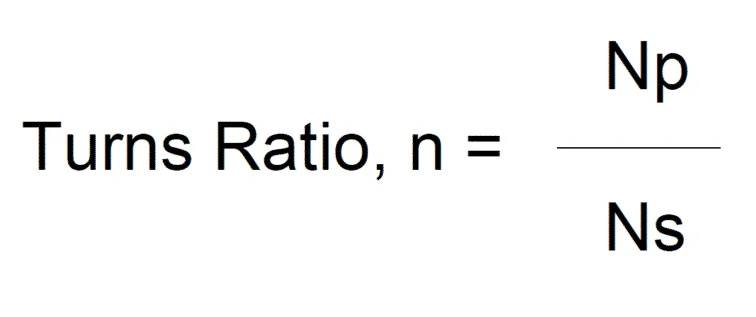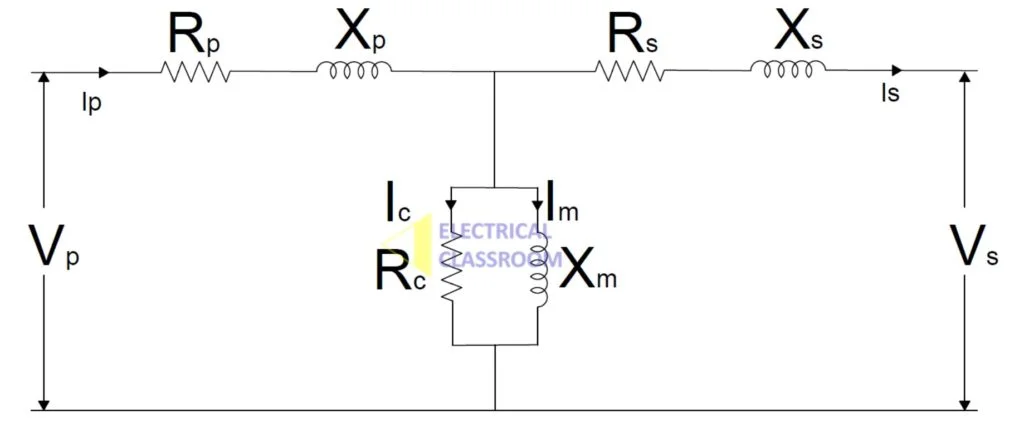The primary function of a power transformer is to step up or step down voltage as per the requirement. The magnitude of voltage transformation in a transformer depends on its turns ratio. The output voltage of any transformer can be theoretically calculated from its turns ratio. Use the following transformer turns ratio calculator for turns ratio calculation.
Online turns ratio calculator
What is the turns ratio?
Each coil of a transformer contains a certain number of turns of the conductor. The turn ratio is defined as the ratio of the number of turns of the conductor in the primary coil to the number of turns of the conductor in the secondary winding. Let Np be the number of turns of the conductor in the primary coil and Ns be the number of turns of the conductor in the secondary coil then turns ratio of the transformer can be given by the following equation:

Turns ratio in an ideal transformer
An ideal transformer is assumed to have zero winding impedance, zero leakage flux, and zero losses. For an ideal transformer, consider an ideal transformer with Np number of turns in the primary and Ns number of turns in the secondary. Let Vp be the voltage applied to the primary at a frequency of ‘f’, and the Vp be the voltage measured at the secondary. Let φbe the flux linking both coils.
The voltage induced per turn of the primary is given by
Vp / Np = k. φm.f
Where k is a constant and φm is the maximum flux. From the above equation,
φm = Vp / Np. k.f
Since the same flux links the primary and the secondary,
Vs / Ns = k. φm.f and φm = Vs / Ns. k.f
Hence, Vp / Np. k.f = Vs / Ns. k.f
Therefore, Vp / Np= Vs / Ns and Vp / Vs = Np / Ns
Relationship between Turns ratio and current
For an ideal transformer, the input power is always equal to the output voltage.
Hence, Vp. Ip. cosϕ = Vs. Is. cosϕ
Therefore, Vp / Vs= Is / Ip
Where Ip and Is are primary and secondary current respectively.
Hence for an ideal transformer, the output current varies as inversely proportional to the voltage. In a step-up transformer, the primary voltage can be stepped up based on the turns ratio but the load current capability of the same at the stepped-up voltage will reduce as the inverse of the turns ratio.

Transformer turns ratio calculators are invaluable tools for electrical engineers and enthusiasts, simplifying the complex calculations required for transformer design and analysis. These calculators help determine the ratio of the number of turns in the primary coil to the number of turns in the secondary coil, which is crucial for voltage regulation and efficiency.
Steps to Use the Transformer Turns Ratio Calculator:
- Select the Calculation Type:
- Choose from Voltage, Turns, or Current using the dropdown menu.
- The relevant input fields will appear based on your selection.
- Input the Necessary Values:
- For Voltage Calculation:
- Enter the Primary Voltage (in volts).
- Enter the Secondary Voltage (in volts).
- For Turns Calculation:
- Enter the Primary Turns.
- Enter the Secondary Turns.
- For Current Calculation:
- Enter the Primary Current (in amps).
- Enter the Secondary Current (in amps).
- For Voltage Calculation:
- Perform the Calculation:
- Once all the necessary inputs are provided, click the “Calculate” button.
- The calculator will display the Turns Ratio in the designated field.
Example:
If you select “Voltage” and input a Primary Voltage of 240 volts and a Secondary Voltage of 120 volts, the calculator will determine the turns ratio as follows:
Using an online transformer turns ratio calculator streamlines these calculations, ensuring quick and accurate results for your electrical projects.
I need to build a 5000V 1.5 A transformer
What is the size of core is available. I have access to a 3 D printer 12X12inches
What size of metallic core is available, from what seller?
I have access to lots of 12Ga transformer wire, both for primary and secondary.
What do you recomend?
Thanks in advance
Sergio (480-299-9984)
i want to make a step down transformer 220 vac to 24vac with 40 va.
please advise anybody what is turn ratio required.